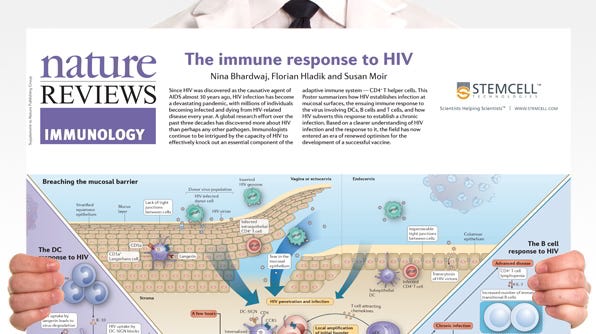Infectious Diseases and Immunology
Infectious diseases are caused by pathogens, including viruses and bacteria. Researchers aim to understand the interactions between these microorganisms and immune cells in order to develop vaccines and therapies against infectious diseases.
Below is a collection of scientific resources for your infectious disease research.
The Immune Response to HIV Poster
Nina Bhardwaj, Florian Hladik and Susan Moir. This Poster summarizes how HIV establishes infection at mucosal surfaces, the ensuing immune response to the virus involving DCs, B cells and T cells, and how HIV subverts this response to establish a chronic infection.
Get Your Free Copy >-
 How to Isolate Cells with EasySepÔäó Column-Free Cell Separation TechnologyIsolation of human CD4+ T cells by negative selection using EasySepÔäó to separate highly purified cells in as little as 8 minutes
How to Isolate Cells with EasySepÔäó Column-Free Cell Separation TechnologyIsolation of human CD4+ T cells by negative selection using EasySepÔäó to separate highly purified cells in as little as 8 minutes -
 How to Count Cells Using a HemocytometerHow to prepare and count stained cell samples using a hemocytometer for both total nucleated cell counts and viable cell counts
How to Count Cells Using a HemocytometerHow to prepare and count stained cell samples using a hemocytometer for both total nucleated cell counts and viable cell counts -
 The Easy 50 EasySepÔäó Magnet: Portable Large-Volume Cell Separation In 25 MinutesLearn to use the portable yet powerful Easy 50 EasySepÔäó magnet to obtain purified cells from large volumes & a variety of sources
The Easy 50 EasySepÔäó Magnet: Portable Large-Volume Cell Separation In 25 MinutesLearn to use the portable yet powerful Easy 50 EasySepÔäó magnet to obtain purified cells from large volumes & a variety of sources -
 Isolate Cells with a Simple Pour-Off: EasySepÔäó Cell Separation TechnologyLearn how to perform the EasySepÔäó pour-off
Isolate Cells with a Simple Pour-Off: EasySepÔäó Cell Separation TechnologyLearn how to perform the EasySepÔäó pour-off -
 Asier S├íez-Ciri├│n, PhDDr. Asier S├íez-Ciri├│n discusses his research on HIV infection, with a focus on understanding how some patients have the ability to control HIV infection
Asier Sáez-Cirión, PhDDr. Asier Sáez-Cirión discusses his research on HIV infection, with a focus on understanding how some patients have the ability to control HIV infection -
 Total Nucleated Cell and Viable Cell CountsAccurate cell counts are important in experiments. Ideally both the total nucleated cell (TNC) count and the viability of the cells should be assessed
Total Nucleated Cell and Viable Cell CountsAccurate cell counts are important in experiments. Ideally both the total nucleated cell (TNC) count and the viability of the cells should be assessed -
 Isolate Cells from Whole Blood without Columns or Magnets: RosetteSepÔäó Immunodensity Cell SeparationDescribes statistical models that can be used to estimate the probability of monoclonality for limiting dilution cloning and semi-solid cloning
Isolate Cells from Whole Blood without Columns or Magnets: RosetteSepÔäó Immunodensity Cell SeparationDescribes statistical models that can be used to estimate the probability of monoclonality for limiting dilution cloning and semi-solid cloning -
 How to Isolate PBMCs from Whole Blood Using Density Gradient Centrifugation (FicollÔäó or LymphoprepÔäó)This technical guide demonstrates how to isolate peripheral blood mononuclear cells from whole blood using density gradient centrifugation
How to Isolate PBMCs from Whole Blood Using Density Gradient Centrifugation (FicollÔäó or LymphoprepÔäó)This technical guide demonstrates how to isolate peripheral blood mononuclear cells from whole blood using density gradient centrifugation -
 The Immune Response to HIV PosterSummary of how HIV subverts the immune response to establish a chronic infection
The Immune Response to HIV PosterSummary of how HIV subverts the immune response to establish a chronic infection -
 Isolating Cells from Atypical SamplesTechnical tip from our dedicated team of Product and Scientific Support specialists
Isolating Cells from Atypical SamplesTechnical tip from our dedicated team of Product and Scientific Support specialists -
 Working with Small Sample Volumes or Low Start Cell Numbers Using the Purple EasySepÔäó and EasyPlateÔäó EasySepÔäó PlatformsTechnical tip from our dedicated team of Product and Scientific Support specialists
Working with Small Sample Volumes or Low Start Cell Numbers Using the Purple EasySepÔäó and EasyPlateÔäó EasySepÔäó PlatformsTechnical tip from our dedicated team of Product and Scientific Support specialists -
 Assessment of Your Starting Sample and Calculation of Recovery from Cell Isolation ProceduresSetting aside a small portion of your starting sample allows you to assess the frequency of desired cells in the sample prior to isolation
Assessment of Your Starting Sample and Calculation of Recovery from Cell Isolation ProceduresSetting aside a small portion of your starting sample allows you to assess the frequency of desired cells in the sample prior to isolation

